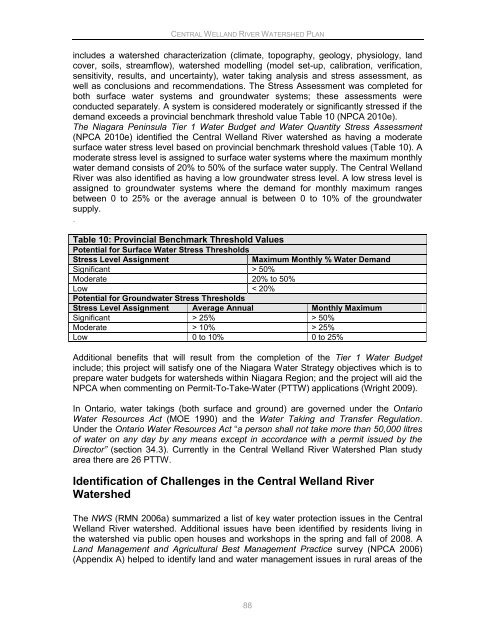Central Welland River Watershed Plan - Niagara Peninsula ...
Central Welland River Watershed Plan - Niagara Peninsula ...
Central Welland River Watershed Plan - Niagara Peninsula ...
- No tags were found...
Create successful ePaper yourself
Turn your PDF publications into a flip-book with our unique Google optimized e-Paper software.
CENTRAL WELLAND RIVER WATERSHED PLANincludes a watershed characterization (climate, topography, geology, physiology, landcover, soils, streamflow), watershed modelling (model set-up, calibration, verification,sensitivity, results, and uncertainty), water taking analysis and stress assessment, aswell as conclusions and recommendations. The Stress Assessment was completed forboth surface water systems and groundwater systems; these assessments wereconducted separately. A system is considered moderately or significantly stressed if thedemand exceeds a provincial benchmark threshold value Table 10 (NPCA 2010e).The <strong>Niagara</strong> <strong>Peninsula</strong> Tier 1 Water Budget and Water Quantity Stress Assessment(NPCA 2010e) identified the <strong>Central</strong> <strong>Welland</strong> <strong>River</strong> watershed as having a moderatesurface water stress level based on provincial benchmark threshold values (Table 10). Amoderate stress level is assigned to surface water systems where the maximum monthlywater demand consists of 20% to 50% of the surface water supply. The <strong>Central</strong> <strong>Welland</strong><strong>River</strong> was also identified as having a low groundwater stress level. A low stress level isassigned to groundwater systems where the demand for monthly maximum rangesbetween 0 to 25% or the average annual is between 0 to 10% of the groundwatersupply..Table 10: Provincial Benchmark Threshold ValuesPotential for Surface Water Stress ThresholdsStress Level AssignmentMaximum Monthly % Water DemandSignificant > 50%Moderate 20% to 50%Low < 20%Potential for Groundwater Stress ThresholdsStress Level Assignment Average Annual Monthly MaximumSignificant > 25% > 50%Moderate > 10% > 25%Low 0 to 10% 0 to 25%Additional benefits that will result from the completion of the Tier 1 Water Budgetinclude; this project will satisfy one of the <strong>Niagara</strong> Water Strategy objectives which is toprepare water budgets for watersheds within <strong>Niagara</strong> Region; and the project will aid theNPCA when commenting on Permit-To-Take-Water (PTTW) applications (Wright 2009).In Ontario, water takings (both surface and ground) are governed under the OntarioWater Resources Act (MOE 1990) and the Water Taking and Transfer Regulation.Under the Ontario Water Resources Act “a person shall not take more than 50,000 litresof water on any day by any means except in accordance with a permit issued by theDirector” (section 34.3). Currently in the <strong>Central</strong> <strong>Welland</strong> <strong>River</strong> <strong>Watershed</strong> <strong>Plan</strong> studyarea there are 26 PTTW.Identification of Challenges in the <strong>Central</strong> <strong>Welland</strong> <strong>River</strong><strong>Watershed</strong>The NWS (RMN 2006a) summarized a list of key water protection issues in the <strong>Central</strong><strong>Welland</strong> <strong>River</strong> watershed. Additional issues have been identified by residents living inthe watershed via public open houses and workshops in the spring and fall of 2008. ALand Management and Agricultural Best Management Practice survey (NPCA 2006)(Appendix A) helped to identify land and water management issues in rural areas of the88
















